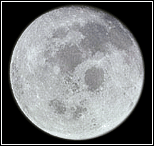Yet the cosmos has decided to ignore the wishes of his family and so Armstrong is getting a special event for the occasion: a blue moon. Either that, or his family is being clever.
If you are not familiar with your old timey terms, "once in a blue moon" has come to signify 'not very often'. Since we get a full moon once every 29.5 days having a second full moon in a month is obviously infrequent, about every 3 years. How long has it been called that? Difficult to say, even the definition of blue moon has changed over time. In western literature, the first reference to it I could find was Bishop William Barlow in the "Treatyse of the Buryall of the Masse" from 1528, who wrote:
Yf they saye the mone is belewe,
We must beleve that it is true.
Why did he mention it? Some years have 13 full moons instead of 12 and people recognized it as long ago as they could determine the period of the moon (which means every culture who learned how to write and do math). Those moons had names everyone of European descent has heard, even if they are not in common usage any more, like 'Paschal Moon', 'Hunter's Moon', 'Harvest Moon', etc. because the full moons matter in determining the date of Easter in Christianity and the original 'blue moon' definition was a season that had 4 full moons instead of 3.
It was in the 1940s that the second full moon in a month came to be the definition; pedants will therefore sniff and smugly declare anyone saying it is wrong, but pedants will also lose at "Trivial Pursuit". They have no one to blame but Sky & Telescope magazine.

Blue Moon? Image: infoplease
The Maine Farmers' Almanac (don't read those? You should, it is still a lot of fun to read the "Farmer's Almanac" today and they are really accurate; oddly, astrology and astronomy co-exist in there peacefully even now) has printed the dates of forthcoming blue moons since 1819. But in 1946, American astronomer James Pruett read the Almanac and misinterpreted the system. His error then got printed as the definition, a 'second full moon in a month', in Sky & Telescope. Whatever, no one read that magazine, but modern types learn from the first 10 hits on Google and from games and once the incorrect answer was printed in "Trivial Pursuit" it was all over for history. That is what the Trivial Pursuit people get for accepting a science magazine over farmers.
The next blue moon will be in July of 2015. Even more special, every 19 years we get two blue moons in one year.
Still, why that name for the special moon? Is the moon ever actually colored blue? Sure, the Krakatoa eruption in Indonesia in 1883 gave us one that got recorded. The moon sometimes looks red at sunset because small dust particles in the air diffract blue light but those larger volcanic dust particles diffract red light - which can make the moon appear blue.
Since fans of space cannot attend the ceremony for Neil Armstrong, his family has instead asked that you look up at the moon and give it a wink. Now you can also annoy your friends at parties by telling them their definition of blue moon is all wrong.
Reference and image link: Once in a Blue Moon by Borgna Brunner and Anne Marie Imbornoni, infoplease



Comments